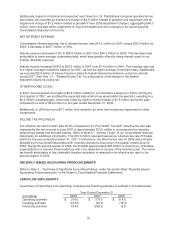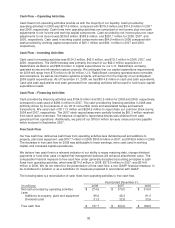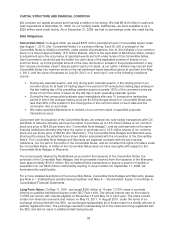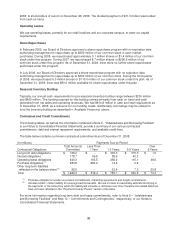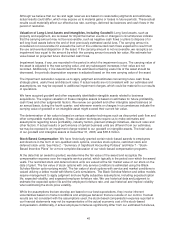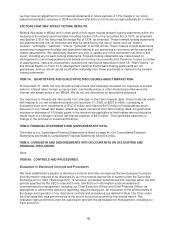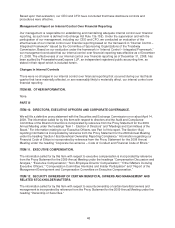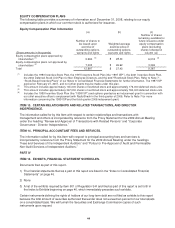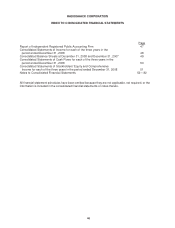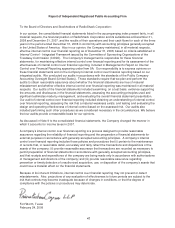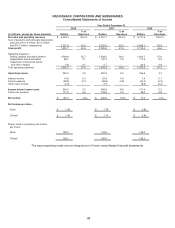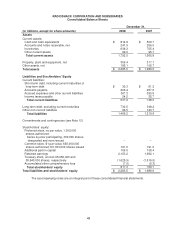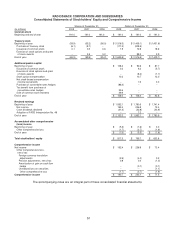Radio Shack 2008 Annual Report Download - page 48
Download and view the complete annual report
Please find page 48 of the 2008 Radio Shack annual report below. You can navigate through the pages in the report by either clicking on the pages listed below, or by using the keyword search tool below to find specific information within the annual report.Although we believe that our tax and legal reserves are based on reasonable judgments and estimates,
actual results could differ, which may expose us to material gains or losses in future periods. These actual
results could materially affect our effective tax rate, earnings, deferred tax balances and cash flows in the
period of resolution.
Valuation of Long-Lived Assets and Intangibles, including Goodwill: Long-lived assets, such as
property and equipment, are reviewed for impairment when events or changes in circumstances indicate
that the carrying amount may not be recoverable, such as negative cash flows or plans to dispose of or
sell long-lived assets before the end of their previously estimated useful lives. The carrying amount is
considered not recoverable if it exceeds the sum of the undiscounted cash flows expected to result from
the use and eventual disposition of the asset. If the carrying amount is not recoverable, we recognize an
impairment loss equal to the amount by which the carrying amount exceeds fair value. We estimate fair
value based on projected future discounted cash flows.
Impairment losses, if any, are recorded in the period in which the impairment occurs. The carrying value of
the asset is adjusted to the new carrying value, and any subsequent increases in fair value are not
recorded. Additionally, if it is determined that the estimated remaining useful life of the asset should be
decreased, the periodic depreciation expense is adjusted based on the new carrying value of the asset.
The impairment calculation requires us to apply judgment and estimates concerning future cash flows,
strategic plans, useful lives and discount rates. If actual results are not consistent with our estimates and
assumptions, we may be exposed to additional impairment charges, which could be material to our results
of operations.
We have acquired goodwill and other separately identifiable intangible assets related to business
acquisitions. The original valuation of these intangible assets is based on estimates for future profitability,
cash flows and other judgmental factors. We review our goodwill and other intangible asset balances on
an annual basis, during the fourth quarter, and whenever events or changes in circumstances indicate the
carrying value of goodwill or an intangible asset might exceed their current fair value.
The determination of fair value is based on various valuation techniques such as discounted cash flow and
other comparable market analyses. These valuation techniques require us to make estimates and
assumptions regarding future profitability, industry factors, planned strategic initiatives, discount rates and
other factors. If actual results or performance of certain business units are different from our estimates,
we may be exposed to an impairment charge related to our goodwill or intangible assets. The total value
of our goodwill and intangible assets at December 31, 2008, was $38.8 million.
Stock-Based Compensation: We have historically granted certain stock-based awards to employees
and directors in the form of non-qualified stock options, incentive stock options, restricted stock and
deferred stock units. See Note 2 - “Summary of Significant Accounting Policies” and Note 7 - “Stock-
Based Incentive Plans” for a more complete discussion of our stock-based compensation programs.
At the date that an award is granted, we determine the fair value of the award and recognize the
compensation expense over the requisite service period, which typically is the period over which the award
vests. The restricted stock and deferred stock units are valued at the fair market value of our stock on the
date of grant. The fair value of stock options with only service conditions is estimated using the Black-
Scholes-Merton option-pricing model. The fair value of stock options with service and market conditions is
valued utilizing a lattice model with Monte Carlo simulations. The Black-Scholes-Merton and lattice models
require management to apply judgment and use highly subjective assumptions, including expected option
life, expected volatility, and expected employee forfeiture rate. We use historical data and judgment to
estimate the expected option life and the employee forfeiture rate, and use historical and implied volatility
when estimating the stock price volatility.
While the assumptions that we develop are based on our best expectations, they involve inherent
uncertainties based on market conditions and employee behavior that are outside of our control. If actual
results are not consistent with the assumptions used, the stock-based compensation expense reported in
our financial statements may not be representative of the actual economic cost of the stock-based
compensation. Additionally, if actual employee forfeitures significantly differ from our estimated forfeitures,
41


